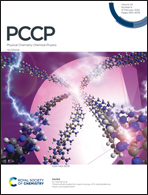Strain modulation on the spin transport properties of PTB junctions with MoC2 electrodes
Abstract
Based on MoC2 nanoribbons and poly-(terphenylene-butadiynylene) (PTB) molecules, we designed MoC2-PTB molecular spintronic devices and investigated their spin-dependent electron transport properties by using spin-polarized density functional theory and the non-equilibrium Green's function method. As a typical MXene material, it is found that the magnetic contribution of MoC2 nanoribbons mainly comes from the delocalized 3d electron of edge Mo atoms. Owing to the obvious spin-splitting near the Fermi level of the MoC2 nanoribbon electrode, the spin states can be effectively injected into the central scattering region under an external bias voltage. In addition, we also studied the effects of z-axis strain on the spin transport properties of the PTB molecular device, where the strain was controlled within the range of −9% to 9%. Under a compressed strain, spin current increases obviously, and the spin-filtering efficiency (SFE) decreases slightly. Nevertheless, under a tensile strain, we found that the SFE increases but spin current decreases. Moreover, z-axis strain can induce a negative differential resistance (NDR) effect at a high bias point. This work would expand the potential applications of new two-dimensional (2D) materials in the field of molecular spintronic devices.



 Please wait while we load your content...
Please wait while we load your content...